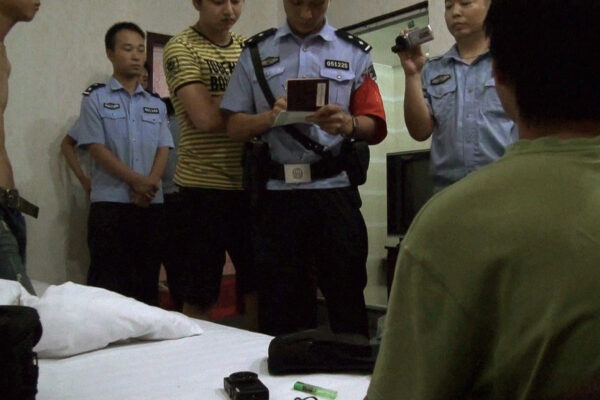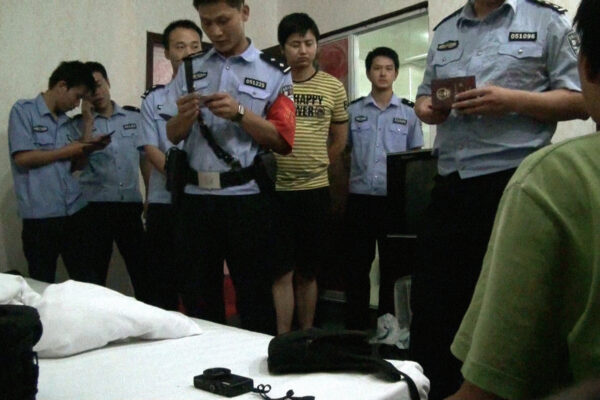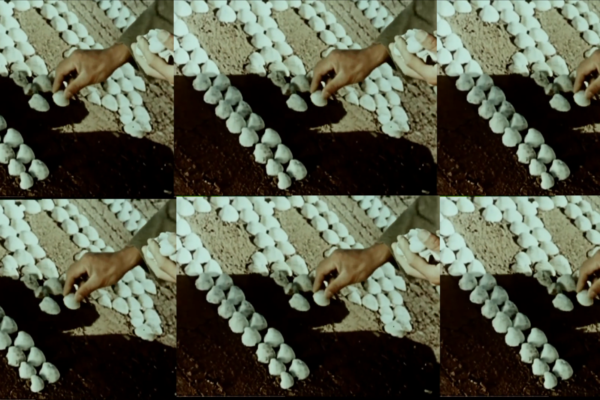Quand | When
26.09.2025 | 19h30
Où | Where
la lumière collective
Média | Media
16mm & numérique
En présence de J.P. Sniadecki
Billets | Tickets
J.P. Sniadecki works between China and the United States towards cinema that explores collective experience, sensory ethnography, and our shared ecology.
J.P. SNIADECKI
J.P. Sniadecki travaille entre la Chine et les États-Unis en tant que cinéaste, éducateur et anthropologue. Ses films font partie des collections permanentes du Museum of Modern Art de New York et du San Francisco Museum of Modern Art, et ont été présentés à la Whitney Biennale, à la Shanghai Biennale, à la Shenzhen Biennale, ainsi que dans des festivals tels que Berlin, BFI, Locarno, Taiwan International Documentary Festival, Cinema du Reel, New York, FICUNAM, Rotterdam, RIDM, etc. Il a cofondé la série de projections itinérantes « Cinema on the Edge », qui présente des films indépendants chinois, a siégé au comité de rédaction du Chinese Independent Cinema Observer et a écrit des articles pour Cinema Scope, Visual Anthropology Review et le volume édité DV-Made China. Il est professeur au département Radio, télévision et cinéma de l’université Northwestern.
J.P. Sniadecki works between China and the US as a filmmaker, educator, and anthropologist. His films are in the permanent collections of New York ‘s Museum of Modern Art and the San Francisco Museum of Modern Art, and have been exhibited at the Whitney Biennale, the Shanghai Biennale, the Shenzhen Biennale, and at festivals such as Berlin, BFI, Locarno, Taiwan International Documentary Festival, Cinema du Reel, New York, FICUNAM, Rotterdam, RIDM, and more. He cofounded the traveling screening series “Cinema on the Edge,” which showcases independent Chinese film, served on the editorial board of Chinese Independent Cinema Observer, and has written articles for Cinema Scope, Visual Anthropology Review, and the edited volume DV-Made China. He is a Professor in the Radio, TV, Film Department at Northwestern University.
CARTE BLANCHE
26.09.2025 | 19h | la lumière collective | 55 mins
Wang Wo | 2007 | Numérique | 10 mins
La place Tiananmen est le symbole de la politique chinoise depuis des centaines d’années, en particulier depuis 1949. Elle est le centre de la Chine.
Up & Down traite d’une rue et d’une place situées au centre de la Chine. Au niveau du sol se trouve la rue Changan, sous terre passe la ligne 1 du métro. De part et d’autre de la rue Changan se trouvent les centres politiques, administratifs, financiers, commerciaux, économiques et de divertissement. Sous la rue Changan se trouve la ligne 1 du métro, « l’artère principale » des transports, où règne une atmosphère bondée, sombre et déprimante. La place Tiananmen est une attraction touristique, un lieu très contrôlé, où se déroulent les cérémonies politiques et où le drapeau national est hissé et descendu chaque jour. Elle montre qu’il y a des dizaines de milliers de personnes sur la place lorsque le drapeau national est hissé et descendu. Les gens regardent et chantent l’hymne national. Cette cérémonie se termine lorsque le drapeau est descendu. La plupart des gens veulent assister au lever et au baisser du drapeau national. C’est devenu un phénomène. Cela fait désormais partie intégrante de l’éducation patriotique et politique. Mais il est difficile de comprendre la cérémonie du baisser du drapeau et beaucoup de gens aiment assister à cette cérémonie. Le paysage et les gens changent constamment sur Changan Road. Le drapeau national est hissé et baissé chaque jour sur la place. Il n’y a pas de haut sans bas. C’est ainsi que vont les choses.
Tiananmen Square is the symbol of Chinese politics for hundreds of years, especially after 1949. It is the center of China.
Up & Down is about a street and a square in the center of China. On the ground is Changan Road, under the ground is the subway 1#. On both sides of Changan Road are the center of politics, authority, finance, trade, business and entertainment. Underground of Changan Road is subway 1#, the “main artery” of transportation, where is crowded, dark and depressing. Tiananmen Square is tourist attractions, a place with lot of control, a place where political ceremony held and where the national flag rising and lowering every day. It presents that there are tens of thousands of people in the square when the national flag rising and lowering. People are watching and singing the national anthem. This ceremony is end with the flag coming down. Most people want to watch the national flag rising and lowering. It is become a phenomenon. It becomes one of the important content of patriotic education and political education. But it’s hard to understand the ceremony of flag lowering and so many people enjoy watching this ceremony. View and people always change on the Changan Road. The national flag is rising and lowering day by day on the square. Where there’s an up, there’s a down. That’s how things go.
Zhu Rikun| 2013 | Numérique | 22 mins
Tôt dans la matinée du 24 juillet 2012, après avoir rencontré des amis à Hong Kong, j’ai pris la voiture de mon frère pour retourner à Shenzhen où j’ai récupéré Guo Feixiong et trois autres amis engagés dans la défense des droits humains. Nous avons ensuite pris la route pour Xinyu, dans la province du Jiangxi, afin d’apporter notre soutien à Liu Ping et à deux autres candidats indépendants locaux. Ils ont été opprimés par le gouvernement et la police pour avoir participé à l’élection et à d’autres événements liés à la défense des droits de l’homme.
Auparavant, d’autres personnes avaient été battues par la police lorsqu’elles s’étaient rendues sur place pour encourager et soutenir les candidats.
Nous nous sommes dépêchés de rejoindre Xinyu avant l’aube du 25 juillet. À l’aube, nous avons trouvé un hôtel où nous avons déposé nos bagages, puis nous sommes allés rencontrer Liu Ping et les autres, nous avons visité un lac situé à proximité où Liu avait été emprisonné et nous les avons interviewés sur leurs expériences. Pendant que nous faisions tout cela, nous avons remarqué que nous étions suivis. À 23 heures, lorsque nous sommes revenus à l’hôtel, plusieurs voitures de police et un groupe de policiers étaient dispersés autour du bâtiment. Le propriétaire de l’hôtel est venu nous voir en toute hâte et nous a dit que la police était déjà entrée dans notre chambre et que cela ne s’était jamais produit auparavant. À minuit, des policiers sont venus dans notre chambre et ont commencé ce qu’ils ont appelé une « inspection de la chambre ».
Quand ils ont commencé à frapper à la porte, j’ai allumé une petite caméra que j’avais préparée à l’avance. Ce court métrage est donc le témoignage de ce moment.
Early in the morning on July 24th, 2012, after meeting some friends in Hongkong, I drove a car of my brother back to Shenzhen and got Guo Feixiong and three other friends who take part in human rights protection to the car and went on driving to Xinyu ,Jiangxi Province to cheer Liu Ping and two other local independent candidates. They have been oppressed by the government and the police for taking part in the election and other human rights protection events.
Before, there were some other people beaten by the police when they went there to cheer and support the candidates.
We hurried to Xinyu before dawn on July 25th. By the time dawn broke, we found a hotel and put our luggage there, then we went to meet Liu Ping and others, went to see a lake where Liu had been imprisoned nearby, and interviewed them about their experiences. While doing these things , we found ourselves tailed. At 11o’clock at night, we came back to the hotel, there were some police cars and a group of policemen scattering by the building. The owner of the hotel came to us in a hurry and told us that the police had already been into our room before, and said it had never happened before. At 12 o’clock at night, some policemen came to our room and started the so-called “room inspection”.
As they began to knock at the door, I turned on a small camcorder which was prepared in advance. So this short film is the record of such a moment.
Zhang Zimu & Tawfiq Nizamidin | 2023 | Numérique | 22 mins
Partant d’une amitié personnelle et d’une réflexion, cette lettre vidéo examine la complexité visuelle, le désenchantement et la repolitisation de l’imagerie des explosions nucléaires en Chine et au-delà. Des documentaires militaires des années 1960 aux films de fiction actuels, les tropes visuels de la première image d’explosion et l’acte même de la contempler dans un paysage nucléaire sont explorés de manière ludique. Au milieu des crises écologiques de l’Anthropocène, cette lettre vidéo suggère que nous pourrions trouver dans la nucléarité des liens radicaux, de l’endurance et de l’amitié.
Departing from personal friendship and reflection, this video letter examines the visual complexity, disenchantment and re-politicization of nuclear detonation imagery in China and beyond. From the 1960s’ military documentary to current fiction films, visual tropes of the first detonation image and the very act of beholding it against the nuclear landscape are playfully teased out. Amid the ecological crises of the Anthropocene, this video letter suggests that in nuclearity we might find radical connections, endurance and friendship.









